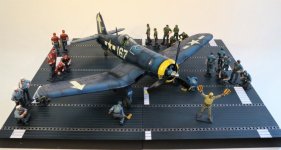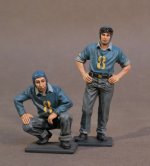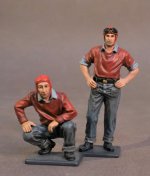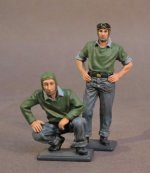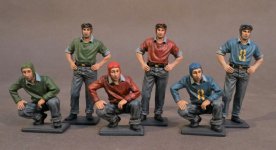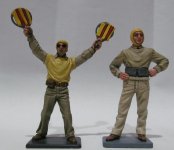NEW RELEASES FOR MARCH 2018
THE SECOND WORLD WAR
GERMAN ARMOUR
The Jagdpanther ( "hunting panther") was a tank destroyer built by Nazi Germany during World War II based on the chassis of the Panther tank. It entered service in 1944 during the later stages of the war on the Eastern and Western Fronts. The Jagdpanther combined the 8.8 cm KwK 43 cannon of the Tiger II and the characteristically excellent armor and suspension of the Panther chassis
Mounting the deadly 8.8 cm PaK 43/3 L/71 cannon and protected by well-sloped 80 mm frontal armor, the Jagdpanther proved its worth as the most fearsome German tank destroyer of the war. Although too few were produced to affect the outcome of the war, the Jagdpanther represented an ideal blend of lethality, armor protection, and mobility that could destroy any allied tank with ease.
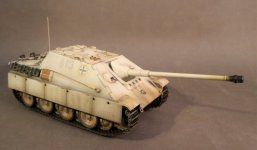
GA-02(813)
THE SECOND WORLD WAR,
GERMANY
Jagdpanther Ausf. G2
2. SS-Panzer Division "Das Reich", 1945,
LAKE BALATON, HUNGARY.
SCALE 1/30
(7 pcs)
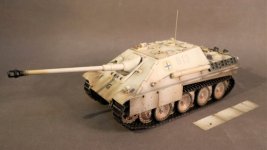
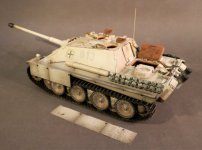
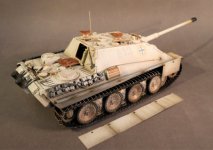
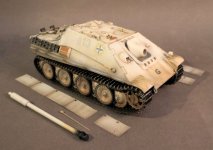
The Jagdpanther Ausf G2 was the final production variant of the deadly "Hunting Panther." It differed from the earlier Jagdpanther Ausf G1 by using the engine configuration of the Panther G. The other main difference was the relocation of external tool stowage from the sides of the vehicle to the engine deck and rear hull. This tool arrangement was recommended by schwere Panzerjäger Abteilung 654, based on their experience in Normandy, and adopted for production.
This model represents a Jagdpanther Ausf G2 of the 2. SS-Panzer Division "Das Reich". Late in the war, German industry could not keep pace with the tremendous losses of armor suffered by the Wehrmacht during the Battle of France, Operation Bagration on the Eastern Front, and the Battle of the Bulge. Consequently, tank destroyers like the Jagdpanther and Hetzer were often issued instead of tanks to Panzer Divisions late in the war. Das Reich was issued Jagpanthers in early February 1945 while it was refitting following the Battle of the Bulge. It used them in the 8. Kompanie of its Panzer Regiment during Operation "Spring Awakening" , the last major panzer offensive of the war around Lake Balaton in Hungary. Das Reich continued to employ Jagdpanthers on the Eastern Front until its eventual surrender to the U.S. Army in May of 1945.
The Das Reich Jagdpanther Ausf G2 comes in winter whitewash with a primer red interior and displays many late production modifications including a raised crew compartment heater over the left engine cooling exhaust fan, sliding plates over the right side air intakes to regulate radiator temperatures, and flame suppressing exhausts (Flammenvernichter). Its markings also include a stylized "G" on the front glacis plate and rear hull sides. This marking was evident on many Jagdpanthers and other panzers during this time frame and meant the vehicle had been treated with the winter antifreeze solution Glysantin. Prominently displayed, the Glysantin "G" alerted crews not to add the summer coolant Akorol, lest catastrophic engine damage occur.
THE SECOND WORLD WAR
GERMAN ARMOUR
The Jagdpanther ( "hunting panther") was a tank destroyer built by Nazi Germany during World War II based on the chassis of the Panther tank. It entered service in 1944 during the later stages of the war on the Eastern and Western Fronts. The Jagdpanther combined the 8.8 cm KwK 43 cannon of the Tiger II and the characteristically excellent armor and suspension of the Panther chassis
Mounting the deadly 8.8 cm PaK 43/3 L/71 cannon and protected by well-sloped 80 mm frontal armor, the Jagdpanther proved its worth as the most fearsome German tank destroyer of the war. Although too few were produced to affect the outcome of the war, the Jagdpanther represented an ideal blend of lethality, armor protection, and mobility that could destroy any allied tank with ease.

GA-02(813)
THE SECOND WORLD WAR,
GERMANY
Jagdpanther Ausf. G2
2. SS-Panzer Division "Das Reich", 1945,
LAKE BALATON, HUNGARY.
SCALE 1/30
(7 pcs)
Model Dimensions 11cm x 23cm x 8.5cm
Model Weight 712g
Model Weight 712g




The Jagdpanther Ausf G2 was the final production variant of the deadly "Hunting Panther." It differed from the earlier Jagdpanther Ausf G1 by using the engine configuration of the Panther G. The other main difference was the relocation of external tool stowage from the sides of the vehicle to the engine deck and rear hull. This tool arrangement was recommended by schwere Panzerjäger Abteilung 654, based on their experience in Normandy, and adopted for production.
This model represents a Jagdpanther Ausf G2 of the 2. SS-Panzer Division "Das Reich". Late in the war, German industry could not keep pace with the tremendous losses of armor suffered by the Wehrmacht during the Battle of France, Operation Bagration on the Eastern Front, and the Battle of the Bulge. Consequently, tank destroyers like the Jagdpanther and Hetzer were often issued instead of tanks to Panzer Divisions late in the war. Das Reich was issued Jagpanthers in early February 1945 while it was refitting following the Battle of the Bulge. It used them in the 8. Kompanie of its Panzer Regiment during Operation "Spring Awakening" , the last major panzer offensive of the war around Lake Balaton in Hungary. Das Reich continued to employ Jagdpanthers on the Eastern Front until its eventual surrender to the U.S. Army in May of 1945.
The Das Reich Jagdpanther Ausf G2 comes in winter whitewash with a primer red interior and displays many late production modifications including a raised crew compartment heater over the left engine cooling exhaust fan, sliding plates over the right side air intakes to regulate radiator temperatures, and flame suppressing exhausts (Flammenvernichter). Its markings also include a stylized "G" on the front glacis plate and rear hull sides. This marking was evident on many Jagdpanthers and other panzers during this time frame and meant the vehicle had been treated with the winter antifreeze solution Glysantin. Prominently displayed, the Glysantin "G" alerted crews not to add the summer coolant Akorol, lest catastrophic engine damage occur.


